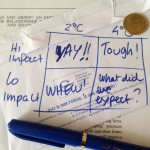How to choose without a crystal ball
We dreamed of flying cars, we got the Internet. We strove to have a base on the moon and fly to the stars, we got comms satellites. The future is never quite like you expect and yet you need to make decisions about it every day.
The problems is not so much that we don’t have a crystal ball and don’t know what the future will be like. The real issue is that our minds are designed to imagine a future in which we succeed by continuing to do exactly what we’re doing no. That simply ain’t gonna happen.
Ask cab drivers how they feel about Uber. Or authors and publishers about Amazon. There is not a walk of like where our current living is not threatened by a mundane change – not walk on the moon stuff, more like realigning of supply chains. And we hate it. We keep telling ourselves these disruptions (after all, they’re quite banal) will pass us by. Wrong thinking: small global changes can have a very large impact at an individual basis.
Half a century ago, Pierre Wack, and executive at Shell, thought of a way of not predicting the future but opening minds instead. Here’s how it goes:
- list the main trends that influence your situation: these are things that you can see today that already have an impact on where you are and what you do.
- rank them by order of most impactful to least impactful
- select out of this list the trends that are the most certain, such as demographics, anything that you feel has already happened although the effects are not all there yet, such as rain in the mountains creates flooding in the plains
- Pick the two most uncertain and most impactful trends of your list: two trends that will have an impact and could go either way – you simply can’t tell which.
For each of these two trends, imagine two distinct futures. For instance, with global warming:
- Best case, 2°C warming above pre-industrial: the world gets warmer, but continues to work more or less as we are used to
- Not so good case, 4°C warming: everything is different, from coastlines to climate patterns, to arable lands
Now let’s look at human impact on global warming:
- Little impact: whether there is no link between human activities and warming, or whether there is a link but we don’t know how to curve human activities to limit our impact on warming comes to the same thing: no slowing down of the warming.
- High impact: we get lucky and human efforts can and do change temperature increase (after all, we did figure out the ozone layer hole issue).
The trick now is to draw the four boxes:
- 2°C warming and low human impact: we did nothing and nothing happened. Whew.
- 2°C warming and high human impact: we did a lot and saved the day. Yay.
- 4°C warming and low human impact: we did nothing and we all get to boil. Serves us right.
- 4°C warming and high human impact: it was far worse than we think, we fight it as hard as we can but we’re sill in deep trouble.

Now for the creative part. Let’s imagine the world as we know it in each of these boxes. Let’s think back to the known trends, such as demographics, and see how they would act out. This is not about predicting the future, this is about imagining it.
And with these three of four scenarios in mind, let’s plug in our decisions into them. In this example: should I, personally, commit to doing something about climate change and involve myself in the issue? Does it pay to go green, in the words of Prof. Andrew King?
This simple exercise will not help me choose, but it will open my mind to new insights and change how I tell myself the story of what I see around me. For instance: is the Syrian refugee crisis a normal effect of political disruption, or the first sign of the mass exodus we expect from global climate changes?
Thinking differently about the situation won’t necessarily help me to make the right bets – I still don’t have a crystal ball – or to invest in the right companies and so on and so for, but it will radically change my relationship to the problem and the situation and spur me to action, somehow, somewhere. Acting will not solve anything – or even save me – but will lead me to explore the problem with greater attention, and progressively understand where the real fault lines lay. Acting in the face of total uncertainty is the first step of true discovery – and the only hope for resolution.
We all know that when in doubt, do something – the question is what? By learning to draw our own back of the enveloppe scenarios, we can learn to open up our thinking and see a path forward in the grey fog of tomorrow.









